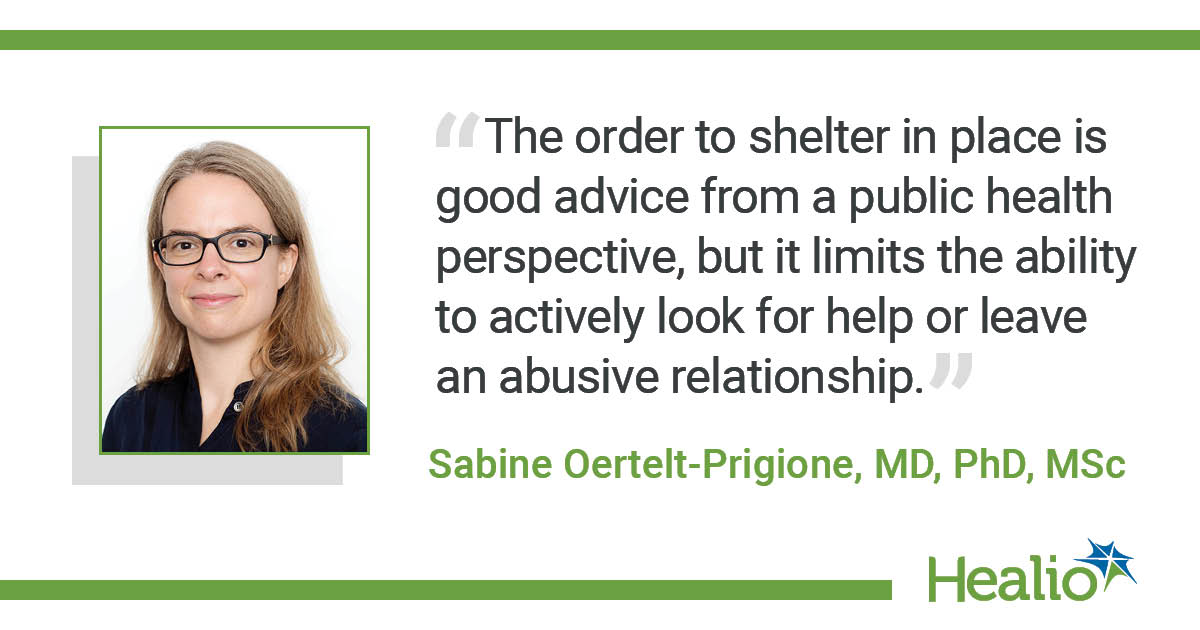Q&A: Screening for intimate partner violence amid COVID-19
In light of social distancing and stay-at-home orders due to the COVID-19 pandemic, physicians should be aware of an increased risk for intimate partner violence among patients “now more than ever,” an expert told Healio Primary Care.
“We see a heightened risk for intimate partner violence in times of crisis,” Sabine Oertelt-Prigione, MD, PhD, MSc, professor of gender in primary and transmural care at Radboud University Medical Center in the Netherlands, said during an interview. “Reports worldwide are, unfortunately, confirming a rise in intimate partner violence.”
Oertelt-Prigione is co-author of a paper published in EClinicalMedicine that discussed how during times of social distancing, feelings of isolation and exposures to personal and collective vulnerabilities that often lead to intimate partner violence are greater than usual. She spoke with Healio Primary Care about screening for intimate partner violence, the unique challenges of identifying such patients during a pandemic and how physicians can help once a patient has been identified. – by Janel Miller
Q: How do you typically screen for intimate partner violence in primary care? How can these strategies be implemented in telehealth?

A: Screening generally involves physical and psychological signs and symptoms. When we see signs such as bruises, scarring and wounds we ask the person about the origin of the physical trauma. If we notice a certain reluctance to describe the nature of the trauma or if what we see appears difficult to reconcile with what is being given as a reason, we will respectfully go further in our questioning.
It is very important to proceed respectfully and empathically and make clear that we are on the side of the survivor of intimate partner violence and that they are not to blame for anything that happened to them. We will ask the survivor if he or she feels safe in their living arrangement and if they feel safe with their potential partners or family members. Unless directly addressed by the survivor, intimate partner violence is not mentioned immediately. Rather, we try to obtain a picture of the general situation of the person in front of us.
In some cases, the violence is not physical, but psychological. We might experience patients that repeatedly describe pain (eg, in the back or stomach), but upon investigation we do not find any objective sign of disease. These recurrent visits might be a request for help and should be carefully investigated as potential signs of violence experience or permanence in an unsafe relationship or living arrangement.
Sometimes survivors are not ready to disclose. In these cases, it is important that the primary care provider clearly communicates that they are always available for help and support in the future. It is important to maintain a nonjudgmental attitude throughout the consultation and validate the experience of the survivor.
Telemedicine limits the opportunity to see some physical trauma and also hampers our ability to gather nonverbal cues. Nevertheless, primary care practitioners still have the opportunity to gather information about the patient’s situation — we can ask if they are feeling safe in their current living arrangements and we can make sure that they know they can always reach out to us for support.
Q: How much more attentive should physicians be to intimate partner violence during the pandemic?
A: During the pandemic, it is important that physicians be aware of the risk, now more than ever. Not only should physicians be more alert for potential intimate partner violence-related causes of the trauma they are witnessing on survivors, they should also be aware of the current barriers victims might be facing in reaching out for help. The order to shelter in place is good advice from a public health perspective, but it limits the ability to actively look for help or leave an abusive relationship. If survivors reach out to health care providers for support, they might be in a more dire situation than we might encounter under normal circumstances given the current restrictions. We are seeing less people visiting the doctor for non-COVID-related symptoms and conditions than we would normally expect. If survivors are reaching out regardless of all the restrictions, the proportion of the ones experiencing extreme distress and acute danger might be larger than expected under normal circumstances.
Q: What advice do you have for physicians who suspect — but cannot confirm — that a person may be a victim of abuse?
A: The most important message health care professionals can convey is that we are always available for a conversation or for help and support. Sometimes it is helpful to describe analogies. Tell the person that you have seen similar bruises in another person experiencing intimate partner violence and what you did to support the other person. Tell the person if something similar to the other patient’s experience ever happened to them, you would always be there to talk to them and support them.
Q: What services are available during the pandemic that physicians can refer patients to?
A: Shelters, hotlines and support services are available. It is important to note that these organizations are needed now more than ever and that states and cities need to make sure they are adequately funded to enable them in providing their services.
Reference:
van Gelder N, et al. EClinicalMedicine. 2020;doi:10.1016/j.eclinm.2020.100348.
Disclosures: The authors report no relevant financial disclosures.

